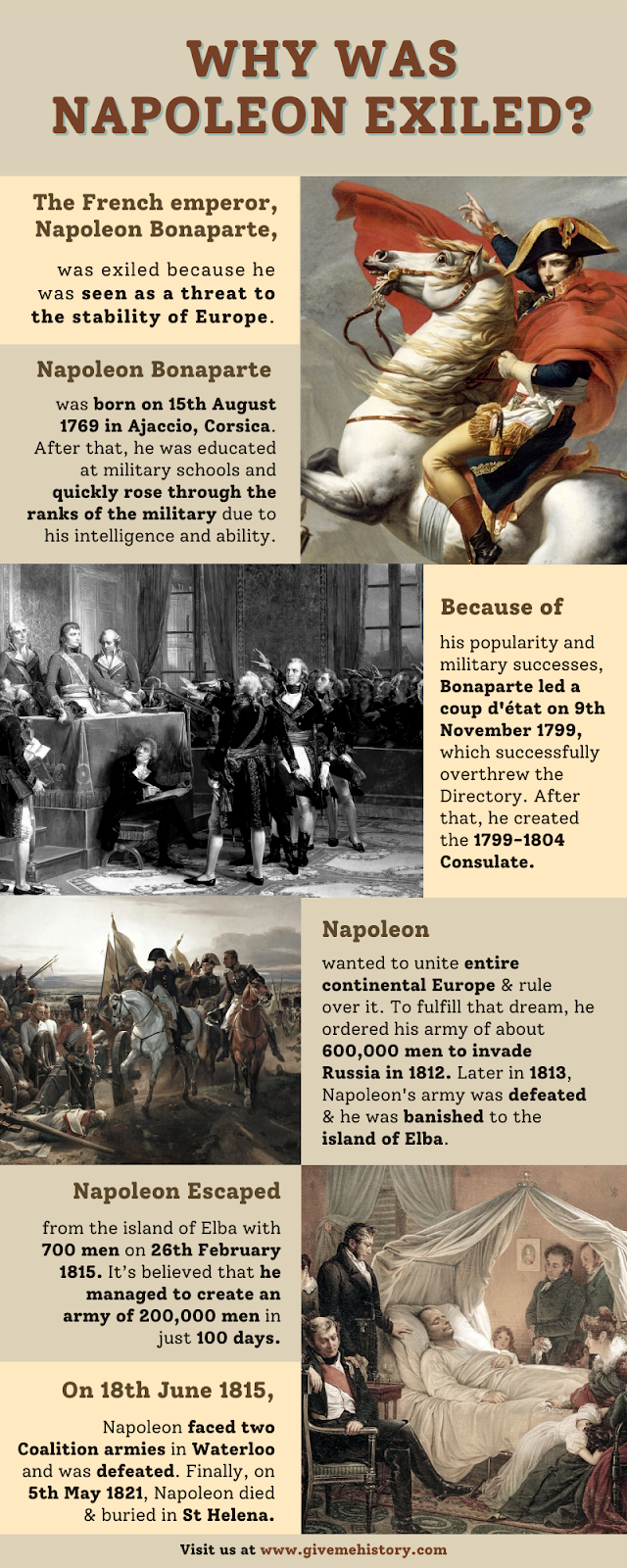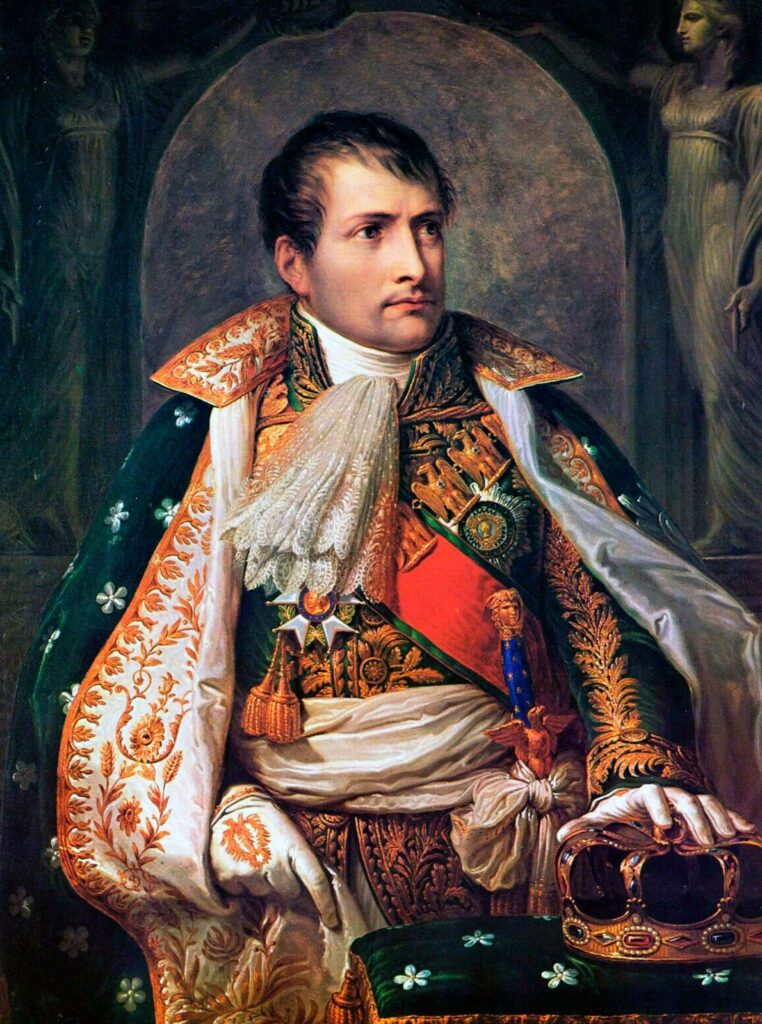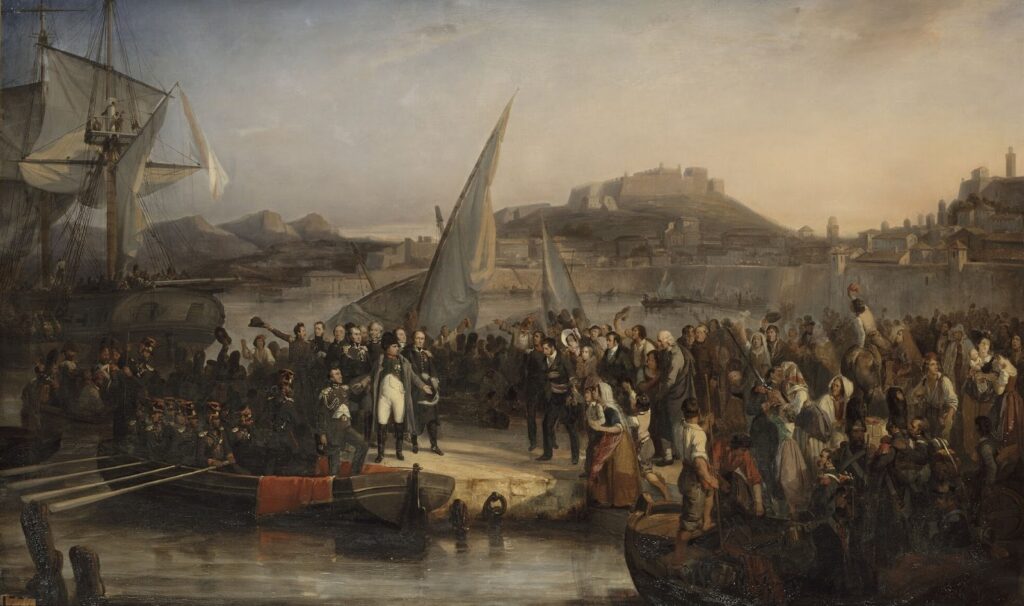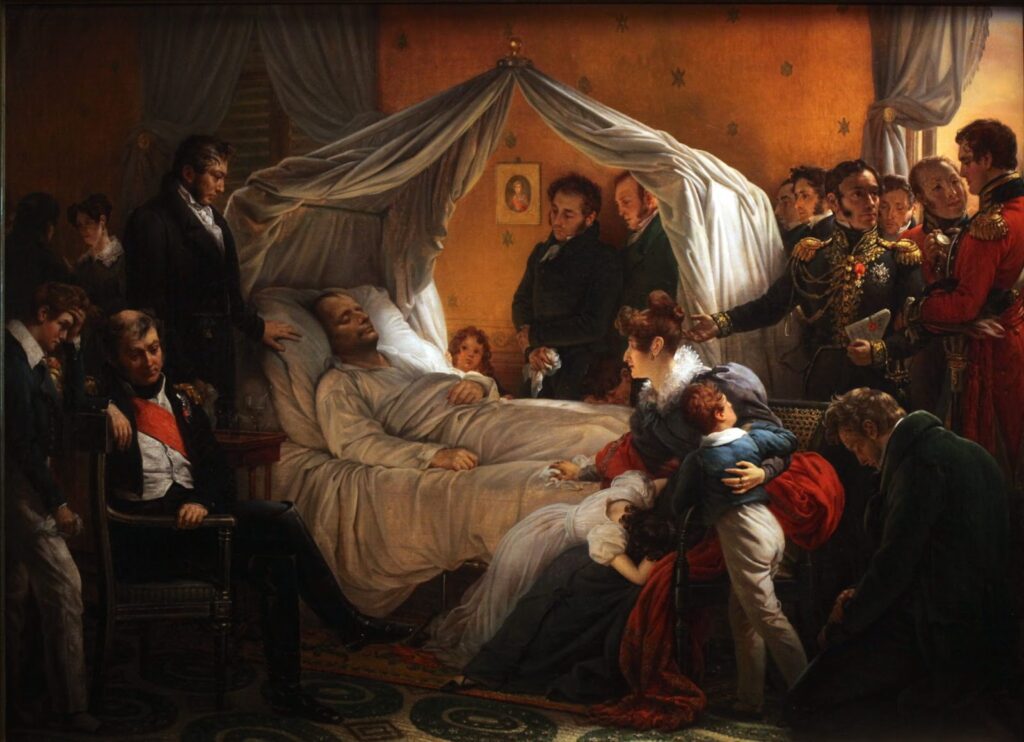法国军事和政治领袖拿破仑皇帝被流放,因为他被视为对欧洲稳定的威胁。
1815 年滑铁卢战役失败后,欧洲战胜国(英国、奥地利、普鲁士和俄罗斯)同意将他流放到圣赫勒拿岛。
但在此之前,拿破仑被派往地中海的厄尔巴岛,作为法国皇帝在那里呆了将近九个月[1]。

目录
早年生活和崛起

意大利国王拿破仑肖像
Andrea Appiani,公共领域,通过维基共享资源
拿破仑-波拿巴于 1769 年 8 月 15 日出生在科西嘉岛的阿雅克肖。 他的家族是意大利血统,在他出生前几年才获得法国贵族身份。
See_also: 海洋的象征意义(十大含义) 拿破仑曾在军校接受教育,凭借自己的智慧和能力在军队中迅速崛起。 1789 年,他支持法国革命[2],并在 18 世纪末率领法国军队多次成功作战。
1793 年,拿破仑携家人定居马赛[3]时,法国正处于国民大会统治之下。 当时,他被任命为围攻土伦要塞部队的炮兵指挥官[4]。
因此,他被提升为准将。
由于声望和军事上的成功,波拿巴于 1799 年 11 月 9 日发动政变,成功推翻了执政党。 之后,他创建了 1799-1804 年执政团(法国政府)。
大多数法国人支持拿破仑夺取政权,因为他们相信这位年轻的将军能为国家带来军事荣耀和政治稳定。
1802 年,他宣布自己为终身执政官,1804 年,他终于成为了法国的皇帝[5]。
从辉煌到拿破仑帝国的终结
欧洲列强对拿破仑的登基并不满意,他们结成了多个军事联盟,以阻止拿破仑扩大对欧洲的统治。
它导致了拿破仑战争,迫使拿破仑打破了法国一个接一个的联盟。
1810 年,拿破仑的声望达到顶峰,因为他的第一任妻子约瑟芬-波拿巴无法生育后嗣,他与她离婚,并与奥地利大公夫人玛丽-路易丝结婚。 次年,他们的儿子 "拿破仑二世 "出生。
拿破仑想统一整个欧洲大陆并统治它。 为了实现这个梦想,他在 1812 年命令其约 60 万人的军队入侵俄罗斯[6]。
这使他得以击败俄国人并占领莫斯科,但由于缺乏补给,法军无法支撑新占领的地区。
研究表明,他的军队中只有 10 万人得以幸存。
1813 年晚些时候,拿破仑的军队在莱比锡被英国怂恿的联军击败,此后他被流放到厄尔巴岛。

描绘拿破仑在费拉约港离开厄尔巴岛的情景
约瑟夫-博梅,公有领域,通过维基共享资源
流放地中海厄尔巴岛
1814 年 4 月 11 日,法国前皇帝拿破仑-波拿巴被欧洲战胜国流放到地中海的厄尔巴岛。
当时的欧洲列强给予他对该岛的主权,并允许他保留皇帝头衔。
换句话说,他是打败他的欧洲列强的俘虏。
他在这个岛上度过了将近九个月,在此期间,他的第一任妻子去世了,但他没能参加她的葬礼。
玛丽-路易丝拒绝陪他一起流亡,他的儿子也不被允许与他见面。
尽管如此,拿破仑仍努力改善厄尔巴岛的经济和基础设施。 他开发了铁矿,建立了一支小规模的陆军和海军,下令修建新的道路,并开始采用现代农业方法。
尽管资源有限且受到种种限制,但他在统治期间仍在改善该岛方面取得了重大进展。
百日和拿破仑之死

描绘拿破仑之死
Charles de Steuben,公有领域,通过维基共享资源
1815 年 2 月 26 日,拿破仑率领 700 人逃离厄尔巴岛[7]。 法国军队第 5 团被派去抓捕他。 1815 年 3 月 7 日,他们在格勒诺布尔以南截住了这位前皇帝。
拿破仑孤身一人到达军队,高喊 "杀了你们的皇帝"[8],但相反,第 5 军团加入了他的行列。 3 月 20 日,拿破仑到达巴黎,据说他在短短 100 天内就创建了一支 20 万人的军队。
See_also: 吸血鬼的象征意义(15 大含义) 1815 年 6 月 18 日,拿破仑在滑铁卢面对两支联军,大败而归。 这一次,他被流放到偏远的南大西洋圣赫勒拿岛。
最后,拿破仑于 1821 年 5 月 5 日在圣赫勒拿岛去世,并被安葬在那里。
最后的话
拿破仑被流放是因为欧洲列强认为他对其安全和稳定构成了威胁。
他被流放到厄尔巴岛,从那里逃了出来,并设法组建了一支强大的军队,但也在 1815 年的滑铁卢战役中被击败。
打败他的欧洲列强,包括英国、奥地利、普鲁士和俄国,担心他可能试图重新夺权,因此同意再次将他流放到偏远的圣赫勒拿岛。
他死在岛上,享年 52 岁。

David Meyer
Jeremy Cruz, a passionate historian and educator, is the creative mind behind the captivating blog for history lovers, teachers, and their students. With a deep-rooted love for the past and an unwavering commitment to spreading historical knowledge, Jeremy has established himself as a trusted source of information and inspiration.Jeremy's journey into the world of history began during his childhood, as he avidly devoured every history book he could get his hands on. Fascinated by the stories of ancient civilizations, pivotal moments in time, and the individuals who shaped our world, he knew from an early age that he wanted to share this passion with others.After completing his formal education in history, Jeremy embarked on a teaching career that spanned over a decade. His commitment to fostering a love for history among his students was unwavering, and he continually sought innovative ways to engage and captivate young minds. Recognizing the potential of technology as a powerful educational tool, he turned his attention to the digital realm, creating his influential history blog.Jeremy's blog is a testament to his dedication to making history accessible and engaging for all. Through his eloquent writing, meticulous research, and vibrant storytelling, he breathes life into the events of the past, enabling readers to feel as if they are witnessing history unfold beforetheir eyes. Whether it's a rarely known anecdote, an in-depth analysis of a significant historical event, or an exploration of the lives of influential figures, his captivating narratives have garnered a dedicated following.Beyond his blog, Jeremy is also actively involved in various historical preservation efforts, working closely with museums and local historical societies to ensure the stories of our past are safeguarded for future generations. Known for his dynamic speaking engagements and workshops for fellow educators, he constantly strives to inspire others to delve deeper into the rich tapestry of history.Jeremy Cruz's blog serves as a testament to his unwavering commitment to making history accessible, engaging, and relevant in today's fast-paced world. With his uncanny ability to transport readers to the heart of historical moments, he continues to foster a love for the past among history enthusiasts, teachers, and their eager students alike.

 意大利国王拿破仑肖像
意大利国王拿破仑肖像  描绘拿破仑在费拉约港离开厄尔巴岛的情景
描绘拿破仑在费拉约港离开厄尔巴岛的情景  描绘拿破仑之死
描绘拿破仑之死 

